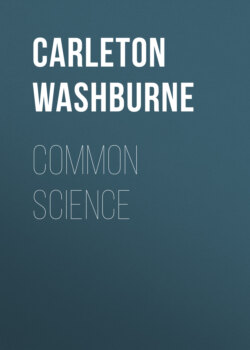Читать книгу Common Science - Carleton Washburne - Страница 11
На сайте Литреса книга снята с продажи.
Fig. 7. The experiment with the Magdeburg hemispheres.
ОглавлениеTable of Contents
Before you pumped the air out of the hemisphere, the compressed air inside of them (you remember all the air down here is compressed) was pushing them apart just as hard as the air outside of them was pushing them together. When you pumped the air out, however, there was hardly any air left inside of them to push outward. So the strong pressure of the outside air against the hemispheres had nothing to oppose it. It therefore pressed them very tightly together and held them that way.
This experiment was first tried by a man living in Magdeburg, Germany. The first set of hemispheres he used proved too weak, and when the air in them was partly pumped out, the pressure of the outside air crushed them like an egg shell. The second set was over a foot in diameter and much stronger. After he had pumped the air out, it took sixteen horses, eight pulling one way and eight the opposite way, to pull the hemispheres apart.
Experiment 7. Fill a bottle (or flask) half full of water. Through a one-hole stopper that will fit the bottle, put a bent piece of glass tubing that will reach down to the bottom of the bottle. Set the bottle, thus stoppered, on the plate of the air pump, with a beaker or tumbler under the outer end of the glass tube. Put the bell jar over the bottle and glass, and pump the air out of the jar. What is it that forces the water up and out of the bottle? Why could it do this when the air was pumped out of the bell jar and not before?
How a seltzer siphon works. A seltzer siphon works on the same principle. But instead of the ordinary compressed air that is all around us, there is in the seltzer siphon a gas (carbon dioxid) which has been much more compressed than ordinary air. This strongly compressed gas forces the seltzer water out into the less compressed air, exactly as the compressed air in the upper part of the bottle forced the water out into the comparative vacuum of the bell jar in Experiment 7.
Experiment 8. Fill a toy balloon partly full of air by blowing into it, and close the neck with a rubber band so that no air can escape. Lay a saucer over the hole in the plate of the air pump, so that the rubber of the balloon cannot be sucked down the hole. Lay the balloon on top of this saucer, put the bell jar over it, and pump the air out of the jar. What makes the balloon expand? What is in it? Why could it not expand before you pumped the air out from around it?
A toy balloon expands for the same reason when it goes high in the air. Up there the air pressure is not so strong outside the balloon, and so the gas inside makes the balloon expand until it bursts.
